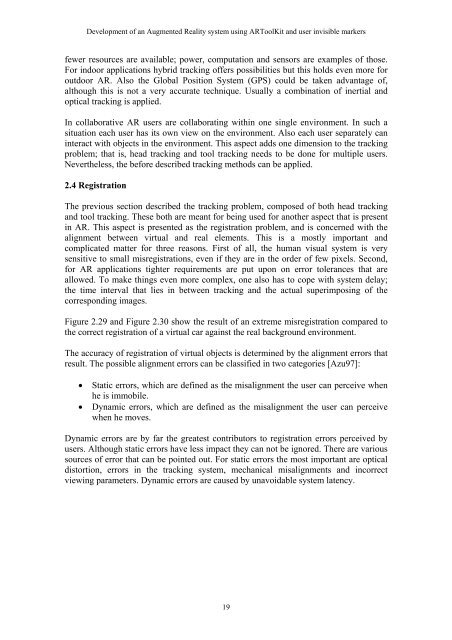Development of an Augmented Reality system using ARToolKit
Development of an Augmented Reality system using ARToolKit
Development of an Augmented Reality system using ARToolKit
Create successful ePaper yourself
Turn your PDF publications into a flip-book with our unique Google optimized e-Paper software.
<strong>Development</strong> <strong>of</strong> <strong>an</strong> <strong>Augmented</strong> <strong>Reality</strong> <strong>system</strong> <strong>using</strong> <strong>ARToolKit</strong> <strong>an</strong>d user invisible markers<br />
fewer resources are available; power, computation <strong>an</strong>d sensors are examples <strong>of</strong> those.<br />
For indoor applications hybrid tracking <strong>of</strong>fers possibilities but this holds even more for<br />
outdoor AR. Also the Global Position System (GPS) could be taken adv<strong>an</strong>tage <strong>of</strong>,<br />
although this is not a very accurate technique. Usually a combination <strong>of</strong> inertial <strong>an</strong>d<br />
optical tracking is applied.<br />
In collaborative AR users are collaborating within one single environment. In such a<br />
situation each user has its own view on the environment. Also each user separately c<strong>an</strong><br />
interact with objects in the environment. This aspect adds one dimension to the tracking<br />
problem; that is, head tracking <strong>an</strong>d tool tracking needs to be done for multiple users.<br />
Nevertheless, the before described tracking methods c<strong>an</strong> be applied.<br />
2.4 Registration<br />
The previous section described the tracking problem, composed <strong>of</strong> both head tracking<br />
<strong>an</strong>d tool tracking. These both are me<strong>an</strong>t for being used for <strong>an</strong>other aspect that is present<br />
in AR. This aspect is presented as the registration problem, <strong>an</strong>d is concerned with the<br />
alignment between virtual <strong>an</strong>d real elements. This is a mostly import<strong>an</strong>t <strong>an</strong>d<br />
complicated matter for three reasons. First <strong>of</strong> all, the hum<strong>an</strong> visual <strong>system</strong> is very<br />
sensitive to small misregistrations, even if they are in the order <strong>of</strong> few pixels. Second,<br />
for AR applications tighter requirements are put upon on error toler<strong>an</strong>ces that are<br />
allowed. To make things even more complex, one also has to cope with <strong>system</strong> delay;<br />
the time interval that lies in between tracking <strong>an</strong>d the actual superimposing <strong>of</strong> the<br />
corresponding images.<br />
Figure 2.29 <strong>an</strong>d Figure 2.30 show the result <strong>of</strong> <strong>an</strong> extreme misregistration compared to<br />
the correct registration <strong>of</strong> a virtual car against the real background environment.<br />
The accuracy <strong>of</strong> registration <strong>of</strong> virtual objects is determined by the alignment errors that<br />
result. The possible alignment errors c<strong>an</strong> be classified in two categories [Azu97]:<br />
• Static errors, which are defined as the misalignment the user c<strong>an</strong> perceive when<br />
he is immobile.<br />
• Dynamic errors, which are defined as the misalignment the user c<strong>an</strong> perceive<br />
when he moves.<br />
Dynamic errors are by far the greatest contributors to registration errors perceived by<br />
users. Although static errors have less impact they c<strong>an</strong> not be ignored. There are various<br />
sources <strong>of</strong> error that c<strong>an</strong> be pointed out. For static errors the most import<strong>an</strong>t are optical<br />
distortion, errors in the tracking <strong>system</strong>, mech<strong>an</strong>ical misalignments <strong>an</strong>d incorrect<br />
viewing parameters. Dynamic errors are caused by unavoidable <strong>system</strong> latency.<br />
19
















